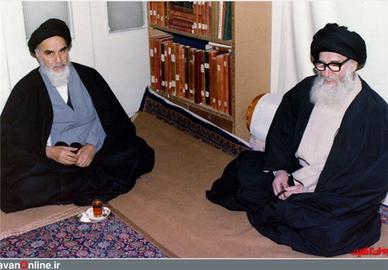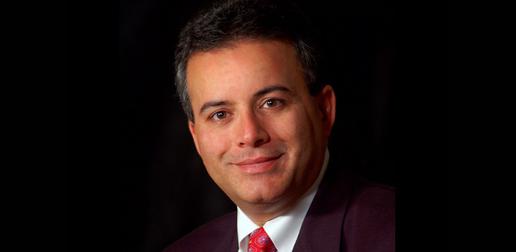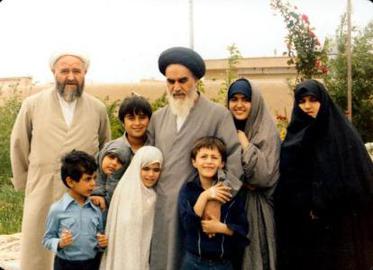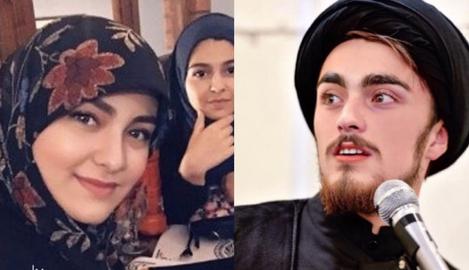The marriage between the great-grandson of Ayatollah Khomeini and the great-granddaughter of Grand Ayatollah Mohammad Reza Golpayegani has hit the headlines in Iran over the last few days, receiving widespread coverage in the media and sparking lively exchanges on social media.
Ahmad Khomeini is the son of Hassan Khomeini, Ayatollah Khomeini’s grandson.
It’s the latest in a series of marriages between Khomeini family members and members of the country’s top clergy and political establishment. The list of the family members involved reads like a mini Who’s Who of the Islamic Republic: The Supreme Leader Ayatollah Ali Khamenei, former president Mohammad Khatami, the late president Akbar Hashemi Rafsanjani, Ayatollah Hossein Kazemeyni Boroujerdi, Ayatollah Mohammad Bagher Soltani Tabatabie, Shahaboddin Eshraghi, Mohammad-Kazem Mousavi-Bojnourdi, Grand Ayatollah Abdul-Karim Haeri Yazdi, Mostafa Mohaghegh Damad, Grand Ayatollah Mohammad Sadegh Hosseini Rohani, the Lebanese Shi’a leader Musa al-Sadr, Jalal Al-Din Taheri Esfahani, Mahmoud Mir Mohammadi Zarandi, Ayatollah Kazem Nour-Mofidi, Javad Shahrestani and Grand Ayatollah Ali al-Sistani.
Mehrzad Boroujerdi, a political scientist and a specialist in Middle Eastern politics at New York’s Syracuse University, has studied marriages among powerful families in the Islamic Republic. He included some of his research in his 2018 book Post-Revolutionary Iran: A Political Handbook, co-authored with Kourosh Rahimkhani. “In my research, I found out that if you include Golpayegani’s family, Khomeini’s family has married into 20 other families,” he says, “and, except for the family of Mohsen Rezaei [the former Revolutionary Guards commander and current Secretary of the Expediency Council], they are all important clergy families in Iran or Iraq.”
The Tradition Goes Way Back
According to Boroujerdi, marriage among the families of clergymen in Shia Iran goes a long way back. “Clergy families usually married members of two groups: Bazaar merchants and the families of other clergymen. Bazaar merchants have always had good relations with the clergy and the people of the seminary schools got to know each other,” he says. “For example, they either shared a dorm room or had a teacher-student relationship. One seminary student might marry the sister of his roommate or the daughter of his master. These marriages were either political or because they were knowledgeable about each other’s past. In a small environment like Qom, it was only logical the families of residents would marry each other. And the seminary students who arrived in Qom from other places joined the clergymen’s network.” He added that when they got into higher classes of Shi’a jurisprudence “the doors to the households of clergymen would open to them and such connections were formed.”
In the Islamic Republic, such ties are not limited to the family of Ayatollah Khomeini. “For instance, Ayatollah Khamenei is related to the families of Kharrazi, Haddad Adel [former chairman of the parliament], Mahdavi Kani [former chairman of the Assembly of Experts and former acting prime minister], Mohammadi Golpayegani [head of the Supreme Leader’s office], and so on,” says Boroujerdi.
But what is the impact of such family connections? “Whether consciously or by chance, they do have many advantages,” he says. “These people can trust each other and this kind of kinship can bring advantages. They can get ahead in politics.”
According to Boroujerdi, family relationships and even relationships based on the fact that people attended the same college or seminary can prevent conflicts. Not only are such connections politically desirable, there is also a historical precedent for them. “It goes back to the prophet of Islam,” he explains. “To establish close relations between his own tribe and other tribes, he married [women] from those tribes and these unions prevented conflicts. Now the same tradition continues.”
And yet in the Islamic Republic, such kinship among the powerful has not been very successful in preventing conflicts. “Kinship did not help in mitigating political conflicts between the reformists and the principlists because sometimes the disagreements are stronger than family connections, especially when the kinship is distant,” he says.
Nepotism Trumps Meritocracy
The issue is that in the Islamic Republic kinship has overshadowed meritocracy. “Because of nepotism,” says Boroujerdi, “people get their positions only because of kinship and are handed offices that they would have never acquired were it not for these family connections. For example, during the presidencies of Hashemi Rafsanjani and Mahmoud Ahmadinejad, their chiefs of staff were their brothers. President Khatami’s chief of staff was also a relative of his. Had Mr. Haddad Adel not been the father-in-law of Khamenei’s son, he would not have had so many positions and jobs. There are many individuals in positions of power only because of these family relations.”
Nevertheless, there are those members of the Khomeini family who are the object of the regime’s and its supporters’ wrath. “We have to make a distinction between the period when Ayatollah Khomeini himself was alive and the one after that,” Boroujerdi points out. “For instance, when Ayatollah Khomeini was alive nobody would insult Ayatollah Jalal Al-Din Taheri, but after Khomeini died, they insulted some members of his family, even his grandchild.” Taheri’s son Mohammad Hossein was married to Khomeini’s granddaughter. After the disputed 2009 presidential election, a revolutionary court sentenced him to four years in prison, 74 lashes and 10 years in exile. “The situation had changed. When political polarization arrived, the family connections were no longer winning cards behind which they could shield themselves.”
But do the family connections of the powerful in the Islamic Republic always last? Have none of these marriages ended in divorce? “There were two cases of divorce in Khomeini’s family,” says Boroujerdi. One was Morteza Eshraghi, Khomeini’s grandson, who married the daughter of Mostafa Mohaghegh, but they divorced. The other was Nafiseh Eshraghi, another granddaughter of Ayatollah Khomeini, who married the son of Mohammad Sadegh Rouhani. That ended in divorce as well.”
visit the accountability section
In this section of Iran Wire, you can contact the officials and launch your campaign for various problems




























comments